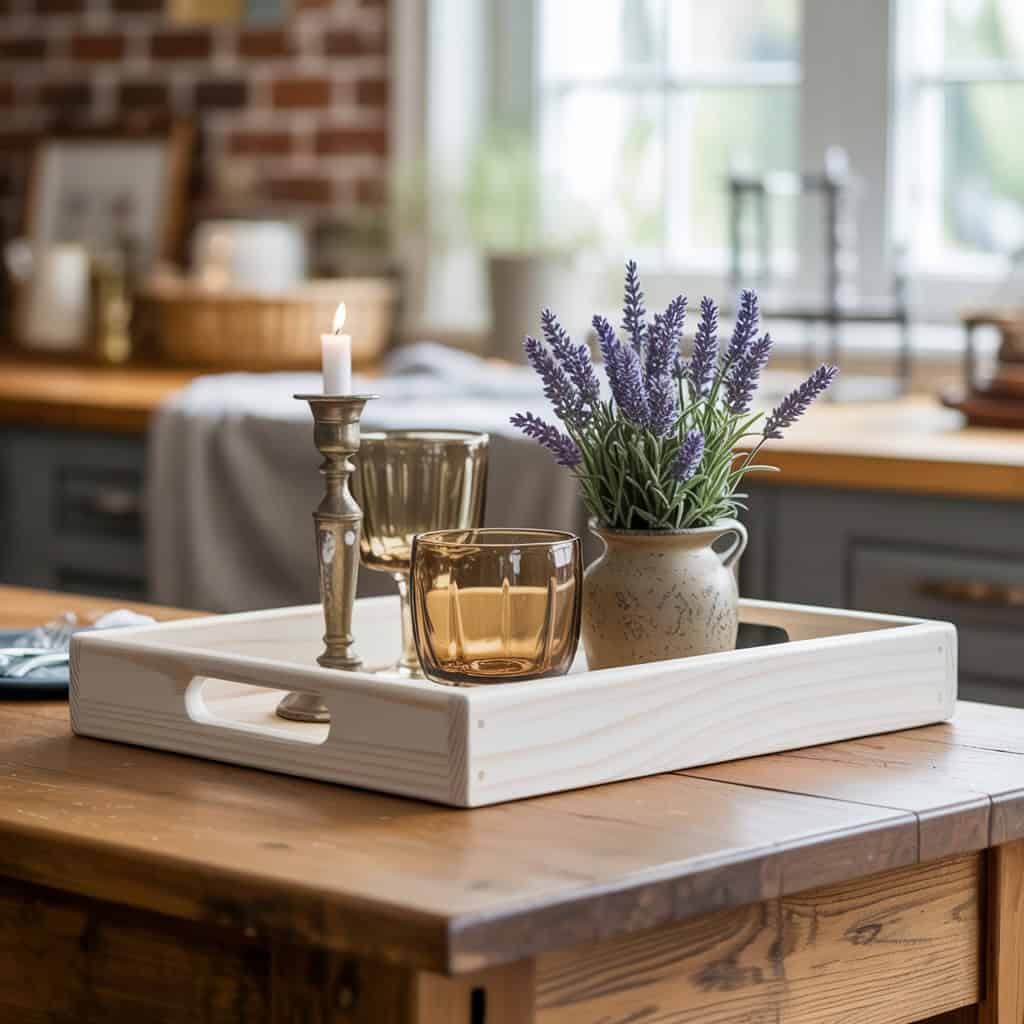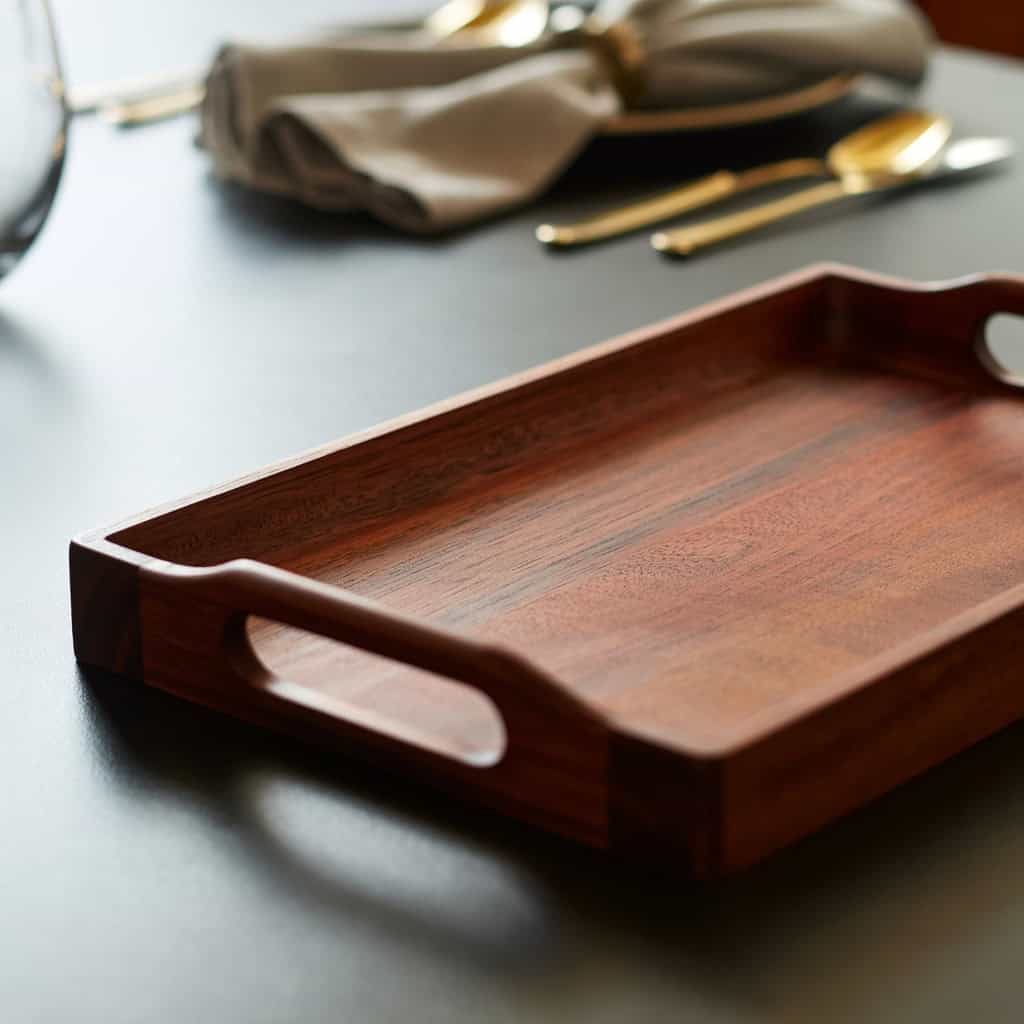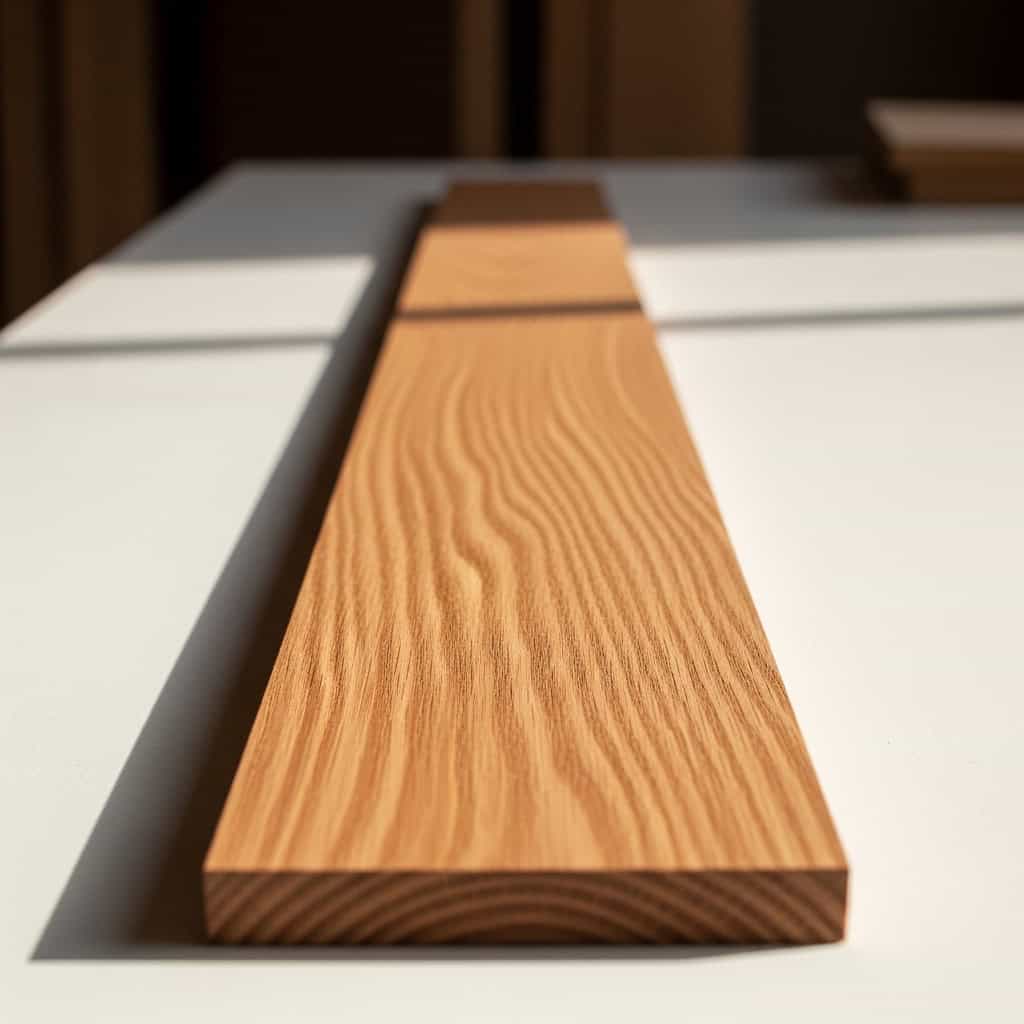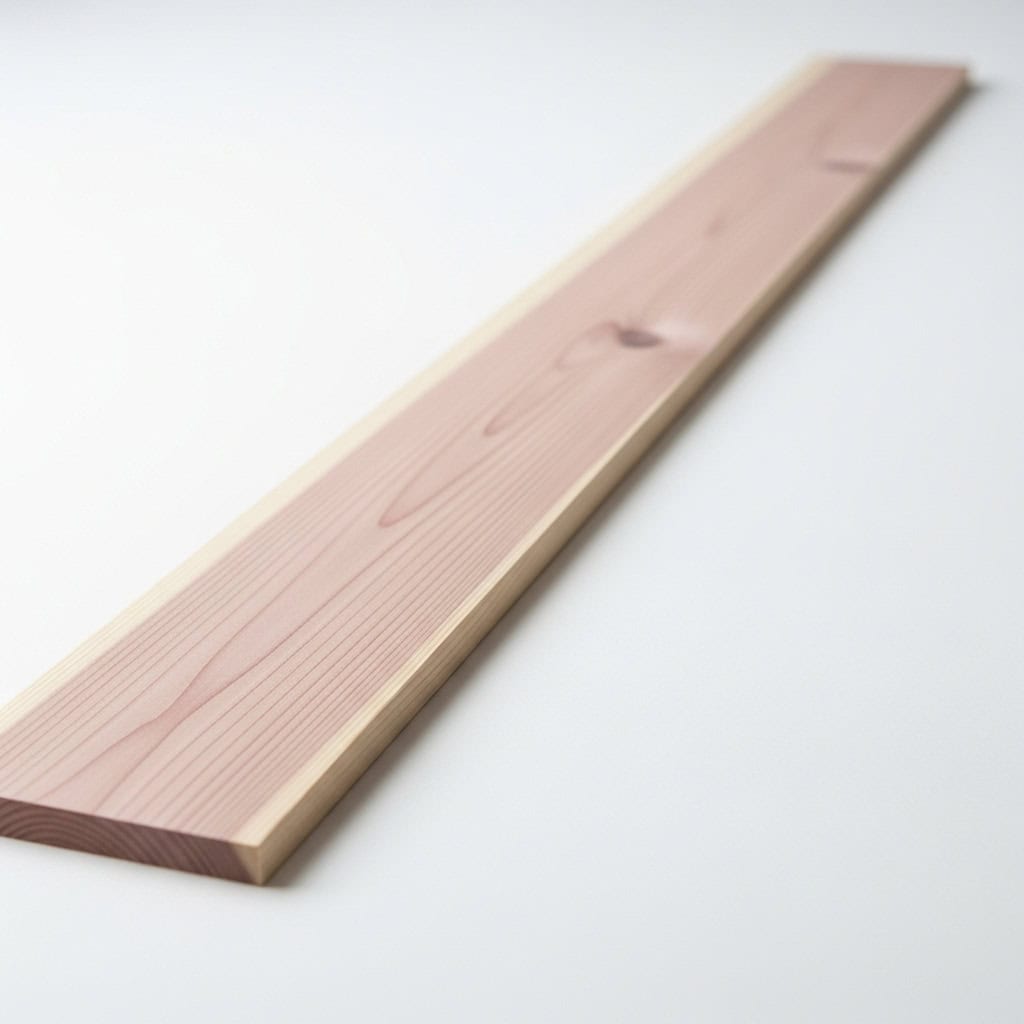I’ve made a handful of serving trays over the years—some for gifts, some to sell, and a few that just live on our coffee table full-time.
They’re simple to build, but like a lot of small projects, the type of wood you choose makes a big difference.
Pick the wrong one, and you might end up with a tray that warps, dents too easily, or doesn’t look right after the finish goes on. Pick the right one, and it’ll hold up to daily use while still looking good on the table or countertop.
Early on, I made the mistake of using scraps or whatever I had lying around. Now, I stick with a few dependable woods that are easy to work with, hold up well, and look great with just a bit of oil or finish.
In this post, I’ll cover what to look for in a serving tray wood, the ones I recommend most, and a few that can cause problems if you’re not careful.
What Makes a Good Wood to Use for Serving Trays

Serving trays might not take the abuse of a cutting board, but they still need to be durable and stable. Between carrying drinks, handling weight, and getting wiped down often, the wood needs to handle a little bit of everything.
Whether you’re building a tray with handles, low-profile edges, or even an inlay design, here’s what I look for when picking the right wood:
- Stability: A tray needs to sit flat, not rock or twist. Woods that warp or cup easily are a no-go.
- Weight: Heavy trays are hard to carry. Dense woods look nice, but too much weight makes them impractical.
- Workability: You’ll often be routing edges or cutting finger joints. Woods that chip or splinter easily make the job harder.
- Grain and Color: The tray’s going to be visible and handled—grain and tone matter. A good-looking wood elevates the entire piece.
- Finish Compatibility: The surface should take finish evenly and resist blotching. It also needs to handle occasional spills and wipes without damage.
If you’re giving it as a gift or planning to use it daily, the right wood can mean the difference between something that lasts and something that warps, cracks, or just doesn’t look great on the table.
7 Woods You Should Use for Serving Trays
1. Walnut

Walnut is one of my favorite choices for serving trays. It’s strong, naturally rich in color, and easy to finish without needing stain.
Why Walnut Works:
- Appearance: Dark brown with beautiful grain contrast
- Grain: Closed and smooth—no need for filler
- Durability: Strong enough for daily use without being too heavy
- Stability: Resists warping, even in thinner panels
- Workability: Cuts and sands cleanly—great for beginners
Watch for: Light sapwood streaks, which can stand out if not blended
2. Cherry

Cherry has a warm tone that deepens with age, giving your tray a rich, lived-in look over time.
Why Cherry Works:
- Appearance: Light reddish-brown that darkens beautifully
- Grain: Tight and smooth—finishes evenly
- Durability: Medium hardness—holds up well for serving use
- Stability: Stays flat and stable with seasonal changes
- Workability: Easy to shape and sand, great for handles or rounded edges
Watch for: Slightly more prone to dents and scratches if handled roughly
3. White Oak

White oak is a strong, dense hardwood that resists moisture and handles abuse well.
Why White Oak Works:
- Appearance: Classic light brown with a straight, even grain
- Grain: Closed enough to finish smoothly with minimal filler
- Durability: Very tough—great for everyday trays
- Stability: Less prone to cupping or movement
- Workability: Cuts well and responds to oil or poly finishes
Watch for: Open pores—may need grain filler if you want a flawless finish
4. Hard Maple

Hard maple is pale and clean-looking but strong enough to take a beating. It gives a crisp, modern feel to trays.
Why Hard Maple Works:
- Appearance: Light cream color with subtle grain
- Grain: Very tight—resists blotching and stains evenly
- Durability: Very hard—great for long-term use
- Stability: Excellent at holding shape, even in dry environments
- Workability: Tough on blades but sands smooth
Watch for: Can be tricky to stain evenly—best left natural or finished with clear coat
5. Ash

Ash is tough, easy to work with, and has a bold grain that stands out—even under a simple oil finish.
Why Ash Works:
- Appearance: Light tan with prominent, open grain
- Grain: Eye-catching and consistent
- Durability: Strong and impact-resistant
- Stability: Holds flat with proper drying and finish
- Workability: Easy to shape and sand
Watch for: The open grain may need filler for a smooth surface
6. Poplar

Poplar isn’t fancy, but it’s great for trays you plan to paint or use casually. It’s lightweight, easy to shape, and budget-friendly.
Why Poplar Works:
- Appearance: Pale wood with green or purple streaks—not great raw, but ideal under paint
- Grain: Closed and smooth—no filler needed
- Durability: Softer than other hardwoods but fine for light-duty trays
- Workability: Very easy to cut, glue, and sand
- Finish: Paints beautifully
Watch for: Dents and scratches easily—use care if building for daily use
7. Sapele

Sapele is a more exotic choice, but it holds up incredibly well and has a grain pattern that really shines.
Why Sapele Works:
- Appearance: Medium brown with ribbon-like, interlocked grain
- Grain: Dense and dramatic—adds a lot of character
- Durability: Hard and stable, handles moisture well
- Workability: Cuts cleanly but can burn if tools are dull
- Finish: Looks great with oil or poly
Watch for: Heavier than most domestic hardwoods—might add weight to the tray.
3 Woods That May Not Be Great for Serving Trays
Some woods might seem like a good choice at first—cheap, lightweight, or easy to find—but they come with downsides that can show up fast in a tray that’s meant to be carried, used, and cleaned regularly.
Here are 3 I usually avoid for serving trays:
1. Pine

Pine is easy to find and inexpensive, but it’s far too soft for a tray that’s going to be handled often. It dents and scratches easily and doesn’t age well under wear.
Why Pine Doesn’t Work Well:
- Softness: Dents and dings from cups, plates, or cutlery
- Grain: Often knotty and uneven—can be hard to sand smooth
- Stability: Warps and cups easily, especially with moisture
- Durability: Tends to wear down and splinter over time
Watch for: Even mild humidity or regular wiping can cause movement or surface issues
Fine for a rustic look—but not for a tray meant to last.
2. Red Oak

Red oak is strong, but the open grain works against it when used for trays. It soaks up spills and is hard to keep clean and smooth.
Why Red Oak Doesn’t Work Well:
- Grain: Very open—traps liquids and crumbs in the pores
- Finish: Can look blotchy without grain filler
- Weight: Heavy, especially when built as a solid-bottom tray
- Workability: Splinters on edges and miters without sharp tools
Watch for: Finishes can feel rough unless you take time to fill and seal the grain
3. Cedar

Cedar smells great and works for outdoor builds—but it’s too soft and unstable for a serving tray. It doesn’t hold up well under wear and tear.
Why Cedar Doesn’t Work Well:
- Aroma: Strong scent that can linger on food or utensils
- Softness: Easily dents and splinters under pressure
- Stability: Prone to warping, especially in thinner pieces
- Finish: Uneven absorption leads to blotchy results
Watch for: Edges crush easily during sanding or assembly
Tips for Finishing and Caring for a Serving Tray

A good finish doesn’t just make a serving tray look better—it helps protect it from moisture, spills, and everyday handling.
Even if the tray won’t see heavy-duty use, you want it to hold up and stay looking clean.
Here’s what I’ve found works best when finishing and maintaining a tray:
Choose a Durable Finish
- Oil + Wax: Great for a natural look. Easy to apply and reapply, but needs more frequent maintenance.
- Wipe-On Poly or Varnish: Adds more protection while keeping a natural feel. Good for trays that see regular use.
- Water-Based Polyurethane: Dries fast, resists yellowing, and holds up well over time—especially for lighter woods like maple.
Sand Smooth and Even
- Start with 120 grit and work up to 220 for a clean surface
- Round over edges slightly—they’ll feel better in the hand and hold finish better
- Pay extra attention to joints and corners where oil can pool or finishes can streak
Apply Finish Carefully
- Use light, even coats—don’t flood the surface
- Let each coat dry fully before adding the next
- Sand lightly between coats with fine grit (320+) if needed for smoothness
Maintain the Tray Over Time
- Wipe with a damp cloth—no soaking or standing water
- For oil finishes, reapply as needed if the wood looks dry
- Avoid harsh cleaners—mild soap and water is all you need
- Store flat or upright in a dry area to prevent movement
Final Thoughts
Serving trays are one of those projects that are easy to build—but the wood you choose can make all the difference in how it looks, feels, and holds up.
Over time, I’ve learned to stick with woods that are stable, durable, and easy to finish. Walnut and cherry are my personal favorites—they look great with just a simple oil and always get compliments.
If I’m trying something new or going for a painted look, poplar is a solid go-to that won’t break the bank.
No matter what style you’re going for—modern, rustic, or something in between—there’s a wood on this list that’ll get the job done.
Just skip the ones that dent, warp, or soak up every spill, and your tray will look better and last longer.
Pick a wood that fits your tools, your finish, and your use—and you’ll end up with something that’s as practical as it is good-looking.
